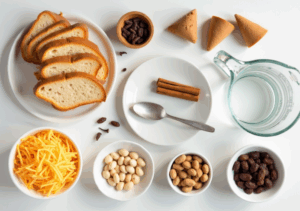Mexican Capirotada: The Soulful Bread Pudding of Lent
Every culture has a dish that evokes memories of family, tradition, and sacred time. In Mexico, that dish is Capirotada—a warm, layered bread pudding that speaks of Lenten reflection, Catholic heritage, and culinary creativity. This sweet-savory dessert is more than a meal; it’s a spiritual ritual passed from one generation to the next.
What is Mexican Capirotada?
Capirotada is a traditional Mexican bread pudding typically prepared during Lent—the 40 days leading up to Easter. This rich, comforting dish is made by layering toasted bread with ingredients like piloncillo syrup, cheese, raisins, peanuts, and warm spices such as cinnamon and clove.
The symbolism of Capirotada is as rich as its flavor. Each component represents a part of the Passion of Christ. The bread symbolizes the Body, the syrup His blood, the cloves the nails, and the cinnamon sticks the wooden cross.
According to the Smithsonian, Mexican culinary traditions like Capirotada are rooted in a mix of indigenous and colonial influences, giving the dish both religious and cultural significance.
A Dish Born of Faith and History
The origins of Capirotada date back to 15th-century Spain, brought to Mexico during the colonial period. It was originally a savory dish, sometimes incorporating meats. But during Lent, when Catholics abstained from eating meat, the recipe evolved into a sweet, bread-based pudding.
The role of the Church in influencing this dish is well documented. As described by the USCCB, Lenten meals are designed to be simple yet nourishing. Capirotada fits this purpose beautifully by turning day-old bread and pantry staples into something sacred and comforting.
Traditional Ingredients in Capirotada
A classic Capirotada recipe uses humble ingredients, often already available in the kitchen:
-
Bolillo or French bread (slightly stale)
-
Piloncillo (unrefined Mexican brown sugar)
-
Mexican cinnamon sticks
-
Cloves
-
Raisins
-
Roasted peanuts
-
Shredded cheese (commonly Monterey Jack or queso fresco)
-
Optional additions: banana slices, dried fruits, or coconut
Each of these ingredients plays a unique role, from texture to taste to religious symbolism.
Variations Across Mexico
Just like other iconic dishes, Capirotada varies by region and household:
-
In Northern Mexico, it’s common to add milk or evaporated milk.
-
Some versions include sweetened condensed milk for a creamier texture.
-
Coastal regions might add tropical fruits like mango or pineapple.
-
In some modern recipes, ingredients like chocolate, coconut flakes, or pecans make appearances.
-
Vegetarian and vegan versions substitute plant-based cheese and syrup alternatives.
Despite these differences, the core of Capirotada—faith, flavor, and family—remains unchanged.
When Is Capirotada Traditionally Eaten?
Capirotada is most often served during:
-
Lent, especially Fridays and Holy Week
-
Good Friday, when fasting is observed
-
Family gatherings, especially in Mexican-American households
-
Church events or potlucks during religious observances
Because it’s meatless and hearty, it became a staple during times of abstinence.
How to Make Traditional Mexican Capirotada
Ingredients
-
6 cups of water
-
3 piloncillo cones
-
3 Mexican cinnamon sticks
-
3 whole cloves
-
1 cup raisins
-
½ cup roasted, salted peanuts
-
12 slices of bolillo or French bread
-
2 cups Monterey Jack cheese, shredded

Instructions
-
Make the syrup
In a medium pot, boil the water, piloncillo, cinnamon, and cloves until it thickens (10–15 minutes). -
Toast the bread
Slice and toast bread in the oven at 350°F for 15–20 minutes. -
Assemble the layers
In a greased baking dish, alternate layers of bread, raisins, peanuts, and cheese. -
Add syrup
Pour syrup evenly over all layers until bread is moist. -
Bake
Cover and bake for 40 minutes or until golden and bubbly.
Enjoy warm, cold, or reheated—Capirotada is always soul-satisfying.
Tips for the Perfect Capirotada
-
Use day-old bread: It holds syrup better and prevents sogginess.
-
Balance your layers: Don’t overload with cheese or nuts.
-
Play with flavors: Try adding orange zest or vanilla for depth.
-
Toast your bread well: It adds texture and prevents a mushy final dish.
Storage and Reheating Tips
-
Store in an airtight container in the fridge for up to 4 days.
-
Reheat in the oven at 300°F for 10–15 minutes or microwave in short bursts.
-
Freeze individual portions for up to 1 month (though best fresh).
Capirotada in Mexican-American Culture
For many families, especially in the U.S., Capirotada is a bridge between generations. It’s not uncommon to hear phrases like, “This tastes just like abuelita made.” Recipes are passed down, often written in notebooks or shared orally.
During Lent, Mexican bakeries and grocery stores often sell pre-toasted bread specifically for this dish—making it even more accessible for busy households.
Frequently Asked Questions
What is Capirotada made of?
It’s made of toasted bread, piloncillo syrup, cheese, raisins, cloves, peanuts, and sometimes dried or tropical fruits.
Is Capirotada served hot or cold?
It can be served warm, at room temperature, or cold depending on preference.
Why do Mexicans eat Capirotada during Lent?
It’s a meatless, symbolic dish created to nourish and reflect during the fasting period of Lent.
How long does it last in the fridge?
Up to 4 days when stored properly.
Can I freeze Capirotada?
Yes, freeze in sealed containers for up to a month. Thaw and reheat before serving.
What cheese is best for Capirotada?
Mild cheeses like Monterey Jack or queso fresco work best due to their meltability and flavor balance.
Final Thoughts
Capirotada is more than a dessert. It’s a prayer on a plate, a tapestry of taste woven with cultural threads. Whether you’re exploring your roots, observing Lent, or simply love Mexican desserts, Capirotada offers warmth, sweetness, and depth in every bite.







